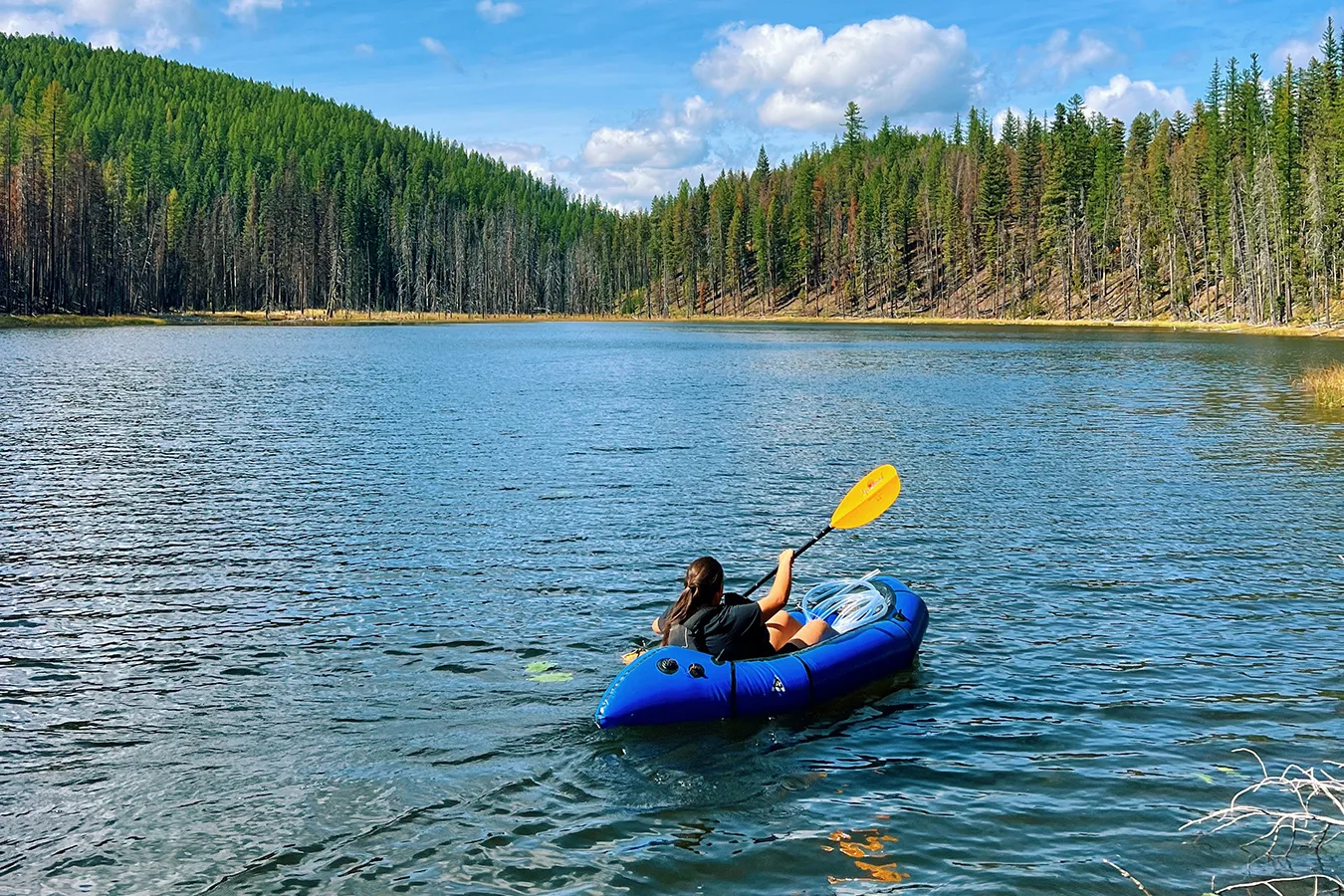By Libby Riddle, UM News Service
MISSOULA – Brooke Bain-White has dedicated her career to studying high-elevation watersheds across the West. A decade ago, she flew to a subalpine lake in the North Cascades. Despite its location over 5,000 feet above sea level in a remote part of the national park, Sourdough Lake contained nonnative fish species.
Bain-White, now a Ph.D. candidate in the University of Montana’s Global Climate and Ecology Lab, helped remove these introduced fish, which sparked her interest in human impacts on high-elevation lakes.
“That was my first awakening that even the most pristine and remote ecosystems have had some human impacts,” Bain-White said.
Originally from Bellingham, Washington, her master’s work at Western Washington University investigated the impact of toxic mine wastes in subalpine streams across the North Cascades Range. She spent multiple seasons with the National Park Service working as a seasonal technician for aquatic monitoring projects.
Bain-White (formerly Bannerman) dreamed of a doctoral project that combined her interests in mountain limnology – the study of inland bodies of water – with her desire to integrate the National Park Service into her work. In Missoula and at UM, she’s made this dream a reality.
“I felt like the stars aligned that I was able to study lakes, be near mountains and do it in a national park,” she said.
Fire ecologists have observed dramatic changes to fire activity in the Western U.S. With these observations comes increasing interest in how fire affects our nation’s most protected places. Following hundreds of years of intentional fire use by Indigenous people, parts of Glacier National Park have burned nearly every year since it was established, making it the perfect place to investigate fire impacts on lake systems.
In 2018, the National Park Service discovered a substantial rise in nutrient concentrations in Lake McDonald, one of Glacier’s most visited lakes. Increases in nutrients, mainly nitrogen and phosphorus, can cause nuisance growth of algae, threatening the clarity of the park’s lakes, which are among the area’s biggest draws.
Bain-White hypothesized that this increased nutrient content is the result of wildfire activity. Her research, funded by the Glacier National Park Conservancy, investigates the ways in which fire affects high-elevation lakes like Lake McDonald.
One way she is doing this is by creating a nutrient budget.
“If you think of a lake as your bank account, you have a certain amount of money in it,” Bain-White said. “That money is nitrogen and phosphorus.”
The “money” in the lake’s bank account is the result of income and losses. Inputs from streams, precipitation or even septic systems are sources of income. The lake “pays” for the growth of aquatic plants with these nutrients. It also loses nutrients via the lake outlet, if it has one, and through groundwater or material sinking to the lake bottom, where it becomes incorporated into the sediments.
“You take all that together and you have a balance of your account of what’s in your lake,” she said.
Bain-White relies on these sediments to explore lake responses to fire and other environmental changes. Material continuously sinks to the lake bottom, so lake sediments archive conditions of the past. By reconstructing the historical conditions of the lake, Bain-White learned how the lake looked and functioned long ago.
This historical insight does not come without challenges. Rather than rugged terrain or unpredictable weather, Bain-White said, some of the biggest obstacles were in response to her gender.
“I’m the only woman doing research up there on the lakes,” Bain-White said. “I’ve had rangers come and talk to the men around instead of me, even though I’m running the project.”
She has been told that she would be more successful in this field if she were a man and been rejected from seasonal jobs that her less-qualified male colleagues were offered. Despite these setbacks, Bain-White remains in her field due to the cultural shift that has enabled underrepresented people to pursue it. Though progress is slow, she is determined to be a part of it.
“I don’t have a female mentor, but if I could be that to someone, I take that role very seriously,” she said. “I feel like women in academics need someone to look at and say, ‘I can do that, too.’”
Bain-White fulfilled this role for one of her lab’s newest members, Sage Fletcher.
After graduating from Pitzer College in California, Fletcher worked on a climate monitoring forest census in northern Nebraska, then as a volunteer limnology assistant for the Lake Sunapee Protective Association. With LSPA, Fletcher collected water samples from a frozen lake near her New Hampshire hometown.
Inspired by her time setting up catch nets that prevent invasive plants from invading the watershed, she’s now pursuing her master’s degree in systems ecology at UM, where she studies fire impacts on lakes alongside Bain-White.
Fletcher’s research compares lakes in the Seeley-Swan range that were impacted by the 2023 Colt Fire with similar lakes in the area that didn’t experience fire in their surrounding landscapes. She and Bain-White installed sensors in each lake that measure light, temperature and dissolved oxygen. Fletcher also collected water samples that are undergoing chemistry analyses at the Flathead Lake Biological Station. The data will reveal whether wildfire ultimately results in an increase or decrease in rates of primary production (i.e. photosynthesis) or respiration, which combine to determine a lake’s metabolism. These processes are directly influenced by materials that erode into lakes after a fire, such as the nutrients in Bain-White’s budgets.
Bain-White has been there for Fletcher and her research every step of the way. They spent hours on Zoom together before Fletcher was even accepted to the program, and they’ve worked closely in the field and the lab since.
“I feel like Sage’s big sister,” Bain-White said. “What she’s doing and what she’s into is so closely tied to mine – I feel really attached to her work.”
Their collaboration is about more than just their research interests. Bain-White is a firm believer that experiences outside of academia are vital to a scientist’s success.
“You know how the world works; you have more confidence in your experience and your decisions. You have those connections outside to lean on,” she told Fletcher.
In light of her own challenges in the field, Bain-White is paving the way for researchers from underrepresented groups. By supporting younger members of her lab, she’s encouraged an environment where graduate students can flourish not only as scientists, but as mentors and friends.
“It is tremendously helpful to have a person like Brooke to bounce off ideas,” Fletcher said. “Both professionally and personally.”
This sense of support and collaboration is pivotal to Bain-White’s research. Unlike most national parks in the West, Glacier does not have a long-term lake monitoring program. Bain-White’s work is filling that gap while she advocates for implementing more long-term studies. Her Ph.D. will expand the analysis she’s conducted on Lake McDonald to lakes across the Mountain West so she can investigate how any changes may be related to fire.
As Bain-White puts it: “We don’t know what we don’t know until we try to know it.”



